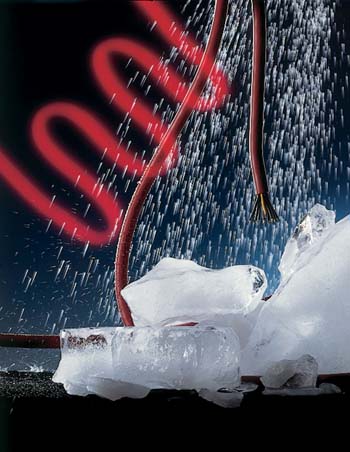
Cables—often made with copper—act like the central nervous system in an automation system, serving as interconnects communicating data, power, or signals between two devices between A and B. When specifying a cable for industrial markets, it is critical to determine what elements exist between A and B.
For example, in motion applications, several types of motion exist—static, flexible, continuous flex, torsion, or a combination of any of these. Cables used in these types of applications are often called continuous flex or flexible and offer an increased service life compared to a regular cable, with a cycle life between one and three million cycles.
Because of the constant motion and bending, it is important that the correct copper stranding is used. Finer copper and increased strand counts of fine-wire gauge will usually last longer, so it does become more expensive due to the extra time to fabricate.
Use of the following factors can increase the service life as much as 100 times compared with standard materials: conductors made of extra fine ETP copper wires according to VDE, TPE insulation, special shielding and PUR sheathing according to international standards.
The motion requirement will also determine what lay length is required when the conductors are cabled together. A continuous flex cable will have a tighter lay length than other types of cable; therefore, more copper is used per foot, thus increasing the cost. So knowing the correct motion is the first step to ensure you are getting the right cable for you application to perform.

Two types of conductor designs
Flexible cables are designed with either the conductors stranded in layers inside the cable or with bundled or braided conductors.
Stranded layers are easier and less expensive to produce. The cores are long and layered, with firm strands that are wrapped with an extruded jacket. One drawback of this design, however, is that the inner radius can compress while the outer radius stretches as the core moves. This can cause material deformation and fatigue, leading to core rupture.
In the bundled or braided design, the conductors are braided around a tension-proof center. By eliminating the layers, a uniform bend radius is ensured, which allows the core to move quickly from inside to outside of the cable during flexing, reducing stress. This design still needs an outer, pressure-filled jacket to prevent the cores from untwisting.
Environmental implications
Depending on the application, the cable may be subjected to additional stress based on the environment it is used in. Understanding this will help ensure the correct jacketing material is used. As with copper stranding, better performance will require better materials with potentially additional cost. If the cable is subjected to washdowns, for example, the jacket will need to withstand the cleaning solution. If used in a machine tool application, oils and metal shavings can present challenges that need to be addressed. If in a clean environment, such as a clean room, the number of particulates the jacket will shed is key to know. Knowing the environment the cable will be exposed to will ensure you are using a cable designed to your needs and that will perform.

Industry approvals
Safety and meeting electrical codes are key points to know when you are selecting a cable. Are you shipping your machine outside the U.S.? Do you know the electrical codes for the country you are shipping to?
It is critical to know some of the following approvals that some cables will require, such as UL, CSA, TC, AWM, RoHS, CE, and more. If you are staying in the US, NEC will set the standards that need to be followed in most cases. The codes will set the UL approvals that are required for the application. Following these standards will ensure that safety and performance measures were followed per NEC. Based on the UL test, the performance features will be defined such as flame rating, voltage, temperature, and possibly oil performance.
Finally, considering insulation and jacketing material is important. Selections can vary from PVC and halogen-free to Neoprene, rubber, silicone and other materials. Shielding must also be taken into consideration, as noise and other electrical interference can impact a cable’s design.


Leave a Reply
You must be logged in to post a comment.